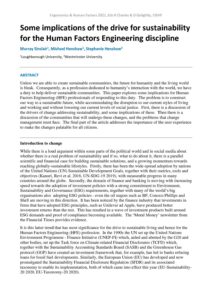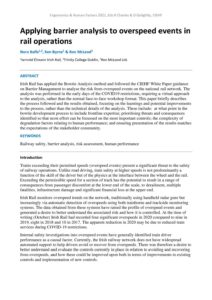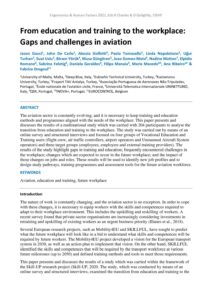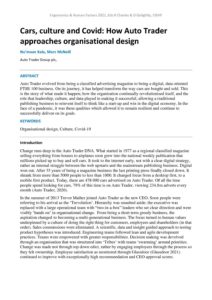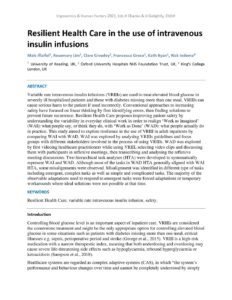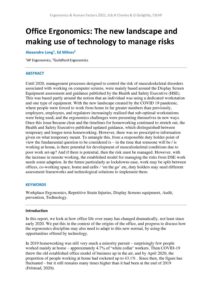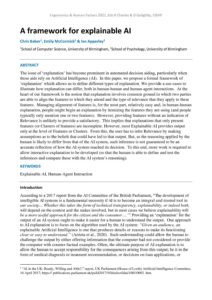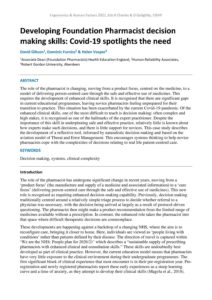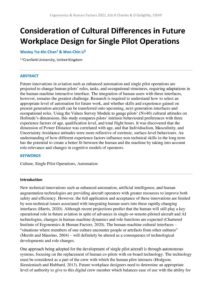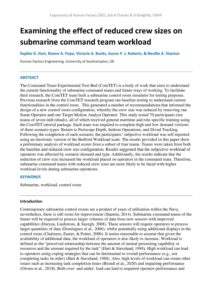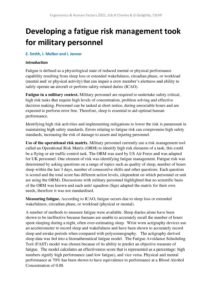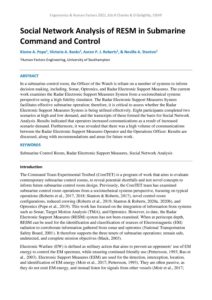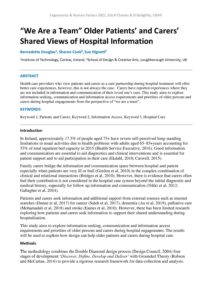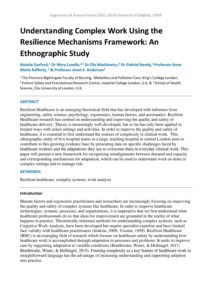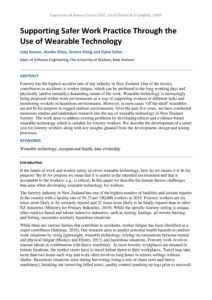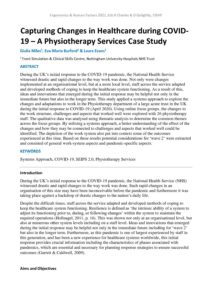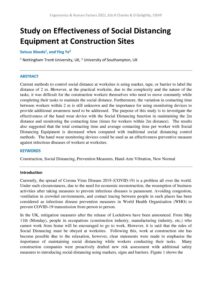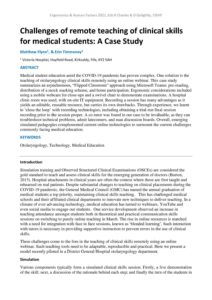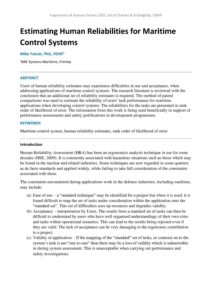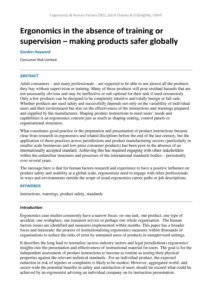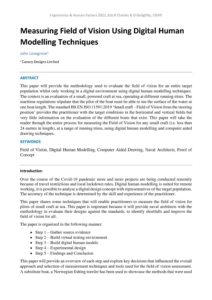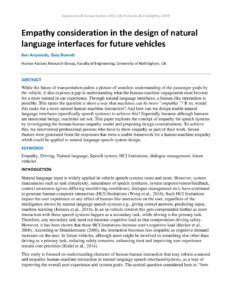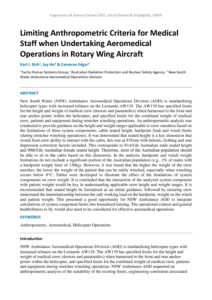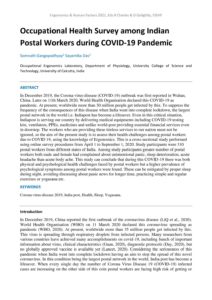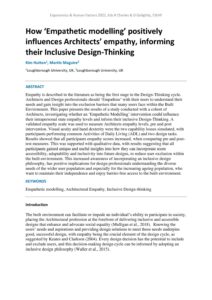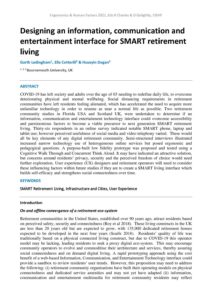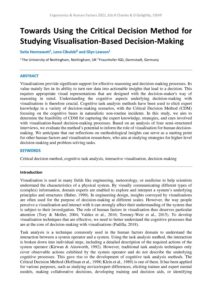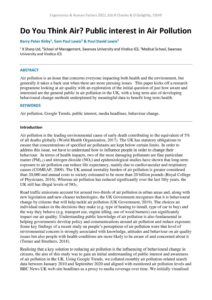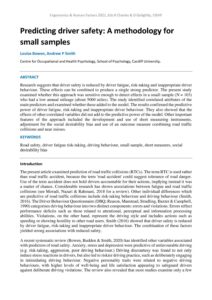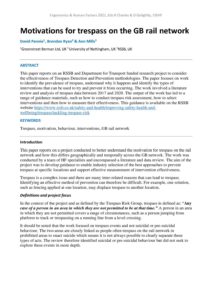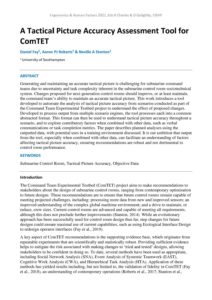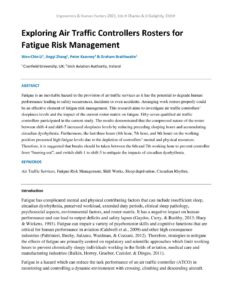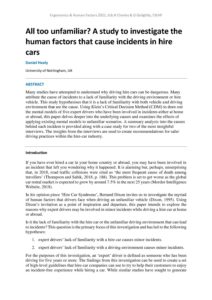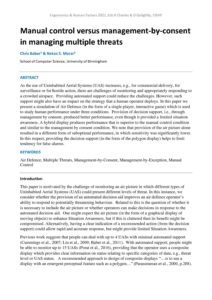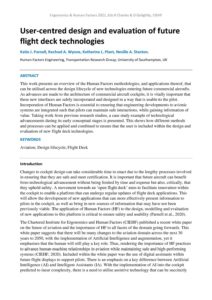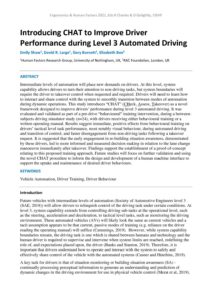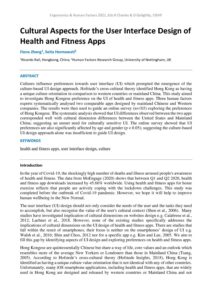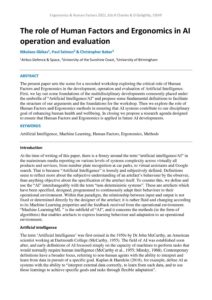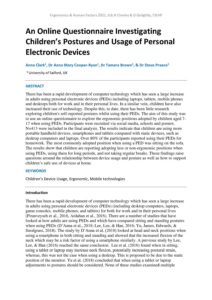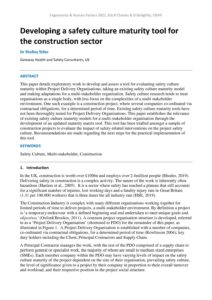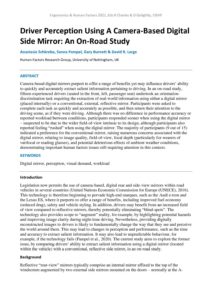Contemporary EHF 2021
Some implications of the drive for sustainability for the Human Factors Engineering discipline
| Document | Author Murray Sinclair, Michael Henshaw and Stephanie Henshaw |
| Abstract Unless we are able to create sustainable communities, the future for humanity and the living world is bleak. Consequently, as a profession dedicated to humanity’s interaction with the world, we have a duty to help deliver sustainable communities. This paper explores some implications for Human Factors Engineering (HFE) professionals of responding to this duty. The problem is to construct our way to a sustainable future, while accommodating the disruption to our current styles of living and working and without lowering our current levels of social justice. First, there is a discussion of the drivers of change addressing sustainability, and some implications of these. Then there is a discussion of the communities that will undergo these changes, and the problems that change management must face. The final part of the article addresses the importance of the user experience to make the changes palatable for all citizens. |
Applying barrier analysis to overspeed events in rail operations
| Document | Author Nora Balfe, Ken Byrne & Ron McLeod |
| Abstract Irish Rail has applied the Bowtie Analysis method and followed the CIEHF White Paper guidance on Barrier Management to analyse the risk from overspeed events on the national rail network. The analysis was performed in the early days of the COVID19 restrictions, requiring a virtual approach to the analysis, rather than the normal face-to-face workshop format. This paper briefly describes the process followed and the results obtained, focusing on the learnings and potential improvements to the process, rather than the technical details of the analysis. These include: at what point in the bowtie development process to include frontline expertise; prioritising threats and consequences identified so that most effort can be focussed on the most important controls; the complexity of degradation factors relating to human performance; and ensuring presentation of the results matches the expectations of the stakeholder community. |
From education and training to the workplace: Gaps and challenges in aviation
| Document | Author Jason Gauci, John De Carlo, Alessia Golfetti, Paola Tomasello, Linda Napoletano, Uğur Turhan, Suat Uslu, Birsen Yörük, Musa Güngören, Joao Gomes-Mota, Nadine Matton, Elpidio Romano, Sabrina Feletig, Daniela Geraldes, Filipa Manaia, Maria Macedo, Ana Ribeiro & Fabrice Drogoul |
| Abstract The aviation sector is constantly evolving, and it is necessary to keep training and education methods and programmes aligned with the needs of the workplace. This paper presents and discusses the results of a multinational study which was carried with 204 participants to analyse the transition from education and training to the workplace. The study was carried out by means of an online survey and structured interviews and focused on four groups of Vocational Education and Training users (flight crew, air traffic controllers, airport operators and Unmanned Aircraft System operators) and three target groups (employees, employers and external training providers). The results of the study highlight gaps in training and education; frequently encountered challenges in the workplace; changes which are expected to occur in the future workplace; and the impact of those changes on jobs and roles. These results will be used to identify new job profiles and to design study pathways, training programmes and assessment tools for the future aviation workforce. |
Cars, culture and Covid: How Auto Trader approaches organisational design
| Document | Author Nu’maan Kala, Marc McNeill |
| Abstract Auto Trader evolved from being a classified advertising magazine to being a digital, data oriented FTSE 100 business. On its journey, it has helped transform the way cars are bought and sold. This is the story of what made it happen; how the organisation continually revolutionised itself, and the role that leadership, culture, and data played in making it successful; allowing a traditional publishing business to reinvent itself to think like a start-up and win in the digital economy. In the face of a pandemic, it was these qualities which allowed it to remain resilient and continue to successfully deliver on its goals. |
Resilient Health Care in the use of intravenous insulin infusions
| Document | Author Mais Iflaifel, Rosemary Lim, Clare Crowley, Francesca Greco, Kath Ryan, Rick Iedema |
| Abstract Variable rate intravenous insulin infusions (VRIIIs) are used to treat elevated blood glucose in severely ill hospitalised patients and those with diabetes missing more than one meal. VRIIIs can cause serious harm to the patient if used incorrectly. Conventional approaches to increasing safety have focused on linear thinking by first identifying errors, then finding solutions to prevent future recurrence. Resilient Health Care proposes improving patient safety by understanding the variability in everyday clinical work in order to realign ‘Work as Imagined’ (WAI): what people say, or think they do, with ‘Work as Done’ (WAD): what people actually do in practice. This study aimed to explore resilience in the use of VRIII in adult inpatients by comparing WAI with WAD. WAI was explored by analysing VRIIIs guidelines and focus groups with different stakeholders involved in the process of using VRIIIs. WAD was explored by first videoing healthcare practitioners while using VRIII, selecting video clips and discussing them with participants in reflexive meetings, then transcribing and analysing the reflexive meeting discussions. Two hierarchical task analyses (HTA) were developed to systematically represent WAI and WAD. Although most of the tasks in WAD HTA generally aligned with WAI HTA, some misalignments were observed. Misalignment was identified in different type of tasks including emergent, complex tasks as well as simple and complicated tasks. The majority of the observable adaptations used to respond to emergent tasks were forced adaptations or temporary workarounds where ideal solutions were not possible at that time. |
Office Ergonomics: The new landscape and making use of technology to manage risks
| Document | Author Alexandre Long, Ed Milnes |
| Abstract Until 2020, management processes designed to control the risk of musculoskeletal disorders associated with working on computer screens, were mainly based around the Display Screen Equipment assessment and guidance published by the Health and Safety Executive (HSE). This was based partly around the notion that an individual was using a dedicated workstation and one type of equipment. With the new landscape created by the COVID 19 pandemic, where people were forced to work from home in far greater numbers than previously, employers, employees, and regulators increasingly realised that sub-optimal workstations were being used, and the ergonomics challenges were presenting themselves in new ways. Once this issue became clear and the timelines for homeworking continued to stretch out, the Health and Safety Executive published updated guidance, which distinguished between temporary and longer-term homeworking. However, there was no prescriptive information given on what temporary meant. To untangle this, from a responsible duty holder point of view the fundamental question to be considered is – in the time that someone will be / is working at home, is there potential for development of musculoskeletal conditions due to poor work set-up? And if there is potential, then the risk must be managed. However, with the increase in remote working, the established model for managing the risks from DSE work needs some adaption. In the future particularly as lockdowns ease, work may be split between offices, co-working space, home and cafés / ‘on the go’ etc, duty holders may need different assessment frameworks and technological solutions to implement them. |
A framework for explainable AI
| Document | Author Chris Baber, Emily McCormick & Ian Apperley |
| Abstract The issue of ‘explanation’ has become prominent in automated decision aiding, particularly when those aids rely on Artificial Intelligence (AI). In this paper, we propose a formal framework of ‘explanation’ which allows us to define different types of explanation. We provide a use-cases to illustrate how explanation can differ, both in human-human and human-agent interactions. At the heart of our framework is the notion that explanation involves common ground in which two parties are able to align the features to which they attend and the type of relevance that they apply to these features. Managing alignment of features is, for the most part, relatively easy and, in human-human explanation, people might begin an explanation by itemizing the features they are using (and people typically only mention one or two features). However, providing features without an indication of Relevance is unlikely to provide a satisfactory. This implies that explanations that only present features (or Clusters of features) are incomplete. However, most Explainable AI provides output only at the level of Features or Clusters. From this, the user has to infer Relevance by making assumptions as to the beliefs that could have led to that output. But, as the reasoning applied by the human is likely to differ from that of the AI system, such inference is not guaranteed to be an accurate reflection of how the AI system reached its decision. To this end, more work is required to allow interactive explanation to be developed (so that the human is able to define and test the inferences and compare these with the AI system’s reasoning). |
Developing Foundation Pharmacist decision making skills: Covid-19 spotlights the need
| Document | Author David Gibson, Dominic Furniss & Helen Vosper |
| Abstract The role of the pharmacist is changing, moving from a product focus, centred on the medicine, to a model of delivering person-centred care through the safe and effective use of medicines. This requires the development of enhanced clinical skills. It is recognised that there are significant gaps in current educational programmes, leaving novice pharmacists feeling unprepared for their transition to practice. This situation has been exacerbated by the current Covid-19 pandemic. Of the enhanced clinical skills, one of the most difficult to teach is decision making: often complex and high stakes, it is recognised as one of the hallmarks of the expert practitioner. Despite the importance of this skill in underpinning safe and effective practice, relatively little is known about how experts make such decisions, and there is little support for novices. This case study describes the development of a reflective tool, informed by naturalistic decision making and based on the aviation model of Threat and Error Management. This encourages systems thinking to help novice pharmacists cope with the complexities of decisions relating to real life patient-centred care. |
Consideration of Cultural Differences in Future Workplace Design for Single Pilot Operations
| Document | Author Wesley Tsz-Kin Chan & Wen-Chin Li |
| Abstract Future innovations in aviation such as enhanced automation and single pilot operations are projected to change human pilots’ roles, tasks, and occupational structures, requiring adaptations in the human-machine interactive interface. The integration of human users with these interfaces, however, remains the greatest challenge. Research is required to understand how to select an appropriate level of automation for future work, and whether skills and experience gained on present generation aircraft can be transferred onto upcoming, next-generation interfaces and occupational roles. Using the Values Survey Module to gauge pilots’ (N=40) cultural attitudes on Hofstede’s dimensions, this study compares pilots’ intrinsic behavioural preferences with three experience factors of age, qualification level, and total flight hours. It was discovered that the dimension of Power Distance was correlated with age, and that Individualism, Masculinity, and Uncertainty Avoidance attitudes were more reflective of extrinsic, surface-level behaviours. An understanding of how different experience factors influence non-technical skills in the long term has the potential to create a better fit between the human and the machine by taking into account role-relevance and changes in cognitive models of operators. |
Examining the effect of reduced crew sizes on submarine command team workload
| Document | Author Sophie G. Hart, Kiome A. Pope, Victoria A. Banks, Aaron P. J. Roberts & Neville A. Stanton |
| Abstract The Command Team Experimental Test-Bed (ComTET) is a body of work that aims to understand the current functionality of submarine command teams and future ways of working. To facilitate their research, the ComTET team built a submarine control room simulator for testing purposes. Previous research from the ComTET research program ran baseline testing to understand current functionalities in the control room. This generated a number of recommendations that informed the design of a new control room configuration, whereby the crew size was reduced by removing one Sonar Operator and one Target Motion Analyst Operator. This study tested 70 participants (ten teams of seven individuals), all of which received general maritime and role-specific training using the ComTET tutorial package. Each team was required to complete high and low demand versions of three scenario types: Return to Periscope Depth, Inshore Operations, and Dived Tracking. Following the completion of each scenario, the participants’ subjective workload was self-reported using an electronic version of the Bedford Workload scale. The results provided in this paper show a preliminary analysis of workload scores from a subset of four teams. Teams were taken from both the baseline and reduced crew size configuration. Results suggested that the subjective workload of operators was affected by scenario demand and type. Additionally, the results indicate that the reduction of crew size increased the workload placed on operators in the command team. Therefore, submarine command teams with reduced crew sizes are more likely to be faced with higher workload levels during submarine operations. |
Developing a fatigue risk management tool for military personnel
| Document | Author E. Smith, I. Mollan and I. Jenner |
| Abstract |
Social Network Analysis of RESM in Submarine Command and Control
| Document |
|
|
| Abstract In a submarine control room, the Officer of the Watch is reliant on a number of systems to inform decision making, including, Sonar, Optronics, and Radar Electronic Support Measures. The current work examines the Radar Electronic Support Measures System from a sociotechnical systems perspective using a high fidelity simulator. The Radar Electronic Support Measures System facilitates effective submarine operation; therefore, it is critical to assess whether the Radar Electronic Support Measures System is being utilised effectively. Eight participants completed two scenarios at high and low demand, and the transcripts of these formed the basis for Social Network Analysis. Results indicated that operators increased communications as a result of increased scenario demand. Furthermore, it was revealed that there was a high volume of communications between the Radar Electronic Support Measures Operator and the Operations Officer. Results are discussed, along with recommendations and areas for future work. |
“We Are a Team” Older Patients’ and Carers’ Shared Views of Hospital Information
| Document | Author Bernadette Douglas, Sharon Cook and Sue Hignett |
| Abstract Health care providers who view patients and carers as a care partnership during hospital treatment will offer better care experiences, however, this is not always the case. Carers have reported experiences where they are not included in information and communication of their loved one’s care. This study aims to explore information seeking, communication and information access requirements and priorities of older persons and carers during hospital engagements from the perspective of “we are a team”. |
Understanding Complex Work Using the Resilience Mechanisms Framework: An Ethnographic Study
| Document | Author Natalie Sanford, Dr Mary Lavelle, Dr Ola Markiewicz, Dr Gabriel Reedy, Professor Anne Marie Rafferty, & Professor Janet E. Anderson |
| Abstract Resilient Healthcare is an emerging theoretical field that has developed with influence from engineering, safety science, psychology, ergonomics, human factors, and aeronautics. Resilient Healthcare research has centred on understanding and improving the quality and safety of healthcare delivery. Theory is increasingly well-developed, but so far has only been applied in limited ways with select settings and activities. In order to improve the quality and safety of healthcare, it is essential to first understand the sources of complexity in clinical work. This ethnographic study of five hospital teams in a large, teaching hospital in central London aims to contribute to this growing evidence base by presenting data on specific challenges faced by healthcare workers and the adaptations they use to overcome them in everyday clinical work. This paper will present a new framework for recognising misalignments between demand and capacity and corresponding mechanisms for adaptation, which can be used to understand work-as-done in complex settings and to manage risk. |
Supporting Safer Work Practice Through the Use of Wearable Technology
| Document | Author Judy Bowen, Annika Hinze, Jemma König and Dylan Exton |
| Abstract Forestry has the highest accident rate of any industry in New Zealand. One of the known contributors to accidents is worker fatigue, which can be attributed to the long working days and physically (and/or mentally) demanding nature of the work. Wearable technology is increasingly being proposed within work environments as a way of supporting workers in different tasks and monitoring workers in hazardous environments. However, in most cases ‘off the shelf’ wearables are not fit for purpose in rugged outdoor environments. Over the past five years, we have conducted numerous studies and undertaken research into the use of wearable technology in New Zealand forestry. The work aims to address existing problems by developing ethical and evidence-based wearable technology which is suitable for forestry workers. We describe the development of a smart vest for forestry workers along with key insights gleaned from the development, design and testing processes. |
Capturing Changes in Healthcare during COVID-19 – A Physiotherapy Services Case Study
| Document | Author Giulia Miles, Eva-Maria Burford & Laura Evans |
| Abstract During the UK’s initial response to the COVID-19 pandemic, the National Health Service witnessed drastic and rapid changes to the way work was done. Not only were changes implemented at an organisational level, but at a more local level, staff across the service adapted and developed methods of coping to keep the healthcare system functioning. As a result of this, ideas and innovations that emerged during the initial response may be helpful not only in the immediate future but also in the longer term. This study applied a systems approach to explore the changes and adaptations to work in the Physiotherapy department of a large acute trust in the UK during the initial response to COVID-19 (April 2020). Using online focus groups, the changes to the work structure, challenges and aspects that worked well were explored with 26 physiotherapy staff. The qualitative data was analysed using thematic analysis to determine the common themes across the focus groups. By utilising a systems approach, a better understanding of the effect of the changes and how they may be connected to challenges and aspects that worked well could be identified. The depiction of the work system also put into context some of the outcomes experienced at this time. Based on these results potential considerations for ‘wave 2’ were extracted and consisted of general work-system aspects and pandemic-specific aspects. |
Study on Effectiveness of Social Distancing Equipment at Construction Sites
| Document | Author Setsuo Maeda and Ying Ye |
| Abstract Current methods to control social distance at worksites is using marker, tape, or barrier to label the distance of 2 m. However, at the practical worksite, due to the complexity and the nature of the tasks, it was difficult for the construction workers themselves who need to move constantly while completing their tasks to maintain the social distance. Furthermore, the variation in contacting time between workers within 2 m is still unknown and the importance for using monitoring devices to provide additional awareness need to be addressed. The purpose of this study is to investigate the effectiveness of the hand wear device with the Social Distancing function in maintaining the 2m distance and monitoring the contacting time (times for workers within 2m distance). The results also suggested that the total contacting time and average contacting time per worker with Social Distancing Equipment is decreased when compared with traditional social distancing control methods. The hand wear monitoring devices could be used as an effectiveness preventive measure against infectious diseases of workers at worksites. |
Challenges of remote teaching of clinical skills for medical students: A Case Study
| Document | Author Matthew Flynn & Erin Timmoney |
| Abstract Medical student education amid the COVID-19 pandemic has proven complex. One solution is the teaching of otolaryngology clinical skills remotely using an online webinar. This case study summarizes an asynchronous, “Flipped Classroom” approach using Microsoft Teams: pre-reading, distribution of a mock marking scheme, and home participation. Ergonomic considerations included using a mobile webcam for close-ups and a swivel chair to demonstrate examinations. A hospital clinic room was used, with on-site IT equipment. Recording a session has many advantages as it yields an editable, reusable resource, but carries its own drawbacks. Through experience, we learnt to ‘close the loop’ with recording technologies, including obtaining a trial-run final session recording prior to the session proper. A co-tutor was found in our case to be invaluable, as they can troubleshoot technical problems, admit latecomers, and man discussion boards. Overall, emerging simulated pedagogies complemented current online technologies to surmount the current challenges commonly facing medical education. |
Estimating Human Reliabilities for Maritime Control Systems
| Document | Author Mike Tainsh |
| Abstract Users of human reliability estimates may experience difficulties in use and acceptance, when addressing applications of maritime control systems. The research literature is reviewed with the conclusion that an additional set of reliability estimates is required. The method of paired comparisons was used to estimate the reliability of users’ task performance for maritime applications when developing control systems. The reliabilities for the tasks are presented in rank order of likelihood of error. The information from this work is being used beneficially in support of performance assessments and safety justifications in development programmes. |
Ergonomics in the absence of training or supervision – making products safer globally
| Document | Author Gordon Hayward |
| Abstract Adult consumers – and many professionals – are expected to be able to use almost all the products they buy without supervision or training. Many of those products will pose residual hazards that are not necessarily obvious and may be ineffective or sub-optimal for their task if used erroneously. Only a few products can be designed to be completely intuitive and totally benign or fail-safe. Whether products are used safely and successfully depends not only on the variability of individual users and their environment but also on the effectiveness of the instructions and warnings prepared and supplied by the manufacturer. Shaping product instructions to meet users’ needs and capabilities is an ergonomics concern just as much as shaping seating, control panels or organisational structures. What constitutes good practice in the preparation and presentation of product instructions became clear from research in ergonomics and related disciplines before the end of the last century, but the application of these practices across jurisdictions and product manufacturing sectors (particularly in smaller scale businesses and low-price consumer products) has been poor in the absence of an internationally accepted standard. Achieving this has required engaging with other stakeholders within the unfamiliar structures and processes of the international standards bodies – persistently over several years. The message here is that for human factors research and experience to have a positive influence on product safety and usability at a global scale, ergonomists need to engage with other professionals in ways and environments outside the scope of usual ergonomics career paths or job descriptions. |
Measuring Field of Vision Using Digital Human Modelling Techniques
| Document | Author John Lovegrove |
| Abstract This paper will provide the methodology used to evaluate the field of vision for an entire target population whilst only working in a digital environment using digital human modelling techniques. The context is an evaluation of a small, powered craft at sea, operating at different running trims. The maritime regulations stipulate that the pilot of the boat must be able to see the surface of the water at one boat length. The standard BS EN ISO 11591:2019 ‘Small craft – Field of Vision from the steering position’ provides the practitioner with the target conditions in the horizontal and vertical fields but very little information on the evaluation of the different boats that exist. This paper will take the reader through the entire process for measuring the Field of Vision for any small craft (i.e. less than 24 metres in length), at a range of running trims, using digital human modelling and computer aided drawing techniques. |
Empathy consideration in the design of natural language interfaces for future vehicles
| Document | Author Ben Anyasodo and Gary Burnett |
| Abstract While the future of transportation paints a picture of seamless understanding of the passenger goals by the vehicle, it also exposes a gap in understanding what the human-machine engagement must become for a more natural in-car experience. Through natural language interfaces, a human-like interaction is possible. This raises the question is there a way that machines can be more “empathic”? If so, would this make for a more natural human-machine interaction? And how can we design usable natural language interfaces (specifically speech systems) to achieve this? Especially because although humans are emotional beings, machines are not. This paper explores the concept of empathy for speech systems by investigating the human-human empathy model and proposing design considerations. To achieve this, we interviewed professional persons who have to show empathy as part of their work. Seven themes were generated from the responses that form a usable framework for a human-machine empathy which could be applied to natural language speech system design. |
Limiting Anthropometric Criteria for Medical Staff when Undertaking Aeromedical Operations in Rotary Wing Aircraft
| Document | Author Karl J. Rich, Joy Ho & Cameron Edgar |
| Abstract New South Wales (NSW) Ambulance Aeromedical Operations Division (AOD) is standardising helicopter types with increased reliance on the Leonardo AW139. The AW139 has specified limits for the height and weight of medical crew (doctors and paramedics) when harnessed to the front and rear anchor points within the helicopter, and specified limits for the combined weight of medical crew, patients and equipment during stretcher winching operations. An anthropometric analysis was conducted to provide guidance on the height and weight ranges applicable to crew members based on the limitations of three system components: cabin seated height, hardpoint limit and winch limits (during stretcher winching operations). It was determined that seated height is a key dimension that would limit crew ability to interact with the cabin, this was at 935mm with helmet, clothing and seat depression correction factors included. This corresponds to 91st%ile Australian male seated height and 99th%ile Australian female seated height. Therefore, most of the Australian population should be able to sit in the cabin based on this dimension. In the analysis, hardpoint and winch weight limitations do not exclude a significant portion of the Australian population (e.g., 3% of males with a hardpoint weight limit of 130kg). However, it was found that the higher the weight of the crew member, the lower the weight of the patient that can be safely winched, especially when winching occurs below 0°C. Tables were developed to illustrate the effect of the limitations of system components on crew weight. It is concluded that the interaction of the analysed system component with patient weight would be key in understanding applicable crew height and weight ranges. It is recommended that seated height be formalised as an initial guidance, followed by ensuring crew understand the interrelationship between the safe working load on the hardpoint, weight on the winch and patient weight. This presented a good opportunity for NSW Ambulance AOD to integrate calculations of system component limits into formalised training. The operational context and general health/fitness to fly would also need to be considered for effective aeromedical operations. |
Occupational Health Survey among Indian Postal Workers during COVID-19 Pandemic
| Document | Author Somnath Gangopadhyay and Sayantika Das |
| Abstract In December 2019, the Corona-virus-disease (COVID-19) outbreak was first reported in Wuhan, China. Later on 11th March 2020, World Health Organisation declared this COVID-19 as pandemic. At present, worldwide more than 30 million people get infected by this. To suppress the frequency of the consequences of this disease when India went into complete lockdown, the largest postal network in the world i.e. Indiapost has become a lifesaver. Even in this critical situation, Indiapost is serving our country by delivering medical equipments including COVID-19 testing kits, ventilators, PPEs, medicines and unlike world-post providing essential financial services even in doorstep. The workers who are providing these tireless services to our nation must not be ignored, so the aim of the present study is to assess their health challenges among postal workers due to COVID 19, using the knowledge of Ergonomics. This is a cross-sectional study performed using online survey procedures from April 1 to September 1, 2020. Study participants were 310 postal workers from different states of India. Among study participants greater number of postal workers both male and female had complained about unintentional panic, sleep deterioration, acute headache than acute body ache. This study can conclude that during this COVID-19 there was both physical and psychological health challenges faced by postal workers but a higher prevalence of psychological symptoms among postal workers were found. These can be mitigated by proper sleep during night, avoiding discussing about panic news for longer time, practicing simple and regular exercises or yogasana etc. |
How ‘Empathetic modelling’ positively influences Architects’ empathy, informing their Inclusive Design-Thinking
| Document | Author Kim Hutton and Martin Maguire |
| Abstract Empathy is described in the literature as being the first stage in the Design-Thinking cycle. Architects and Design professionals should ‘Empathise’ with their users to understand their needs and gain insight into the exclusion barriers that many users face within the Built Environment. This paper presents the results of a study conducted with a cohort of Architects, investigating whether an ‘Empathetic Modelling’ intervention could influence their intrapersonal state empathy levels and inform their inclusive Design-Thinking. A validated empathy scale was used to measure Architects empathy levels, pre and post intervention. Visual acuity and hand dexterity were the two capability losses simulated, with participants performing common Activities of Daily Living (ADL) and two design tasks. Results showed that all participants empathy scores increased, when comparing pre and post-test measures. This was supported with qualitative data, with results suggesting that all participants gained unique and useful insights into how they can incorporate more accessibility, adaptability and inclusivity into future designs, to reduce user exclusion within the built environment. This increased awareness of incorporating an inclusive design philosophy, has positive implications for design professionals understanding the diverse needs of the wider user population and especially for the increasing ageing population, who want to maintain their independence and enjoy barrier-free access to the built environment. |
Designing an information, communication and entertainment interface for SMART retirement living
| Document | Author Garth Ledingham, Ella Cotterill & Huseyin Dogan |
| Abstract COVID-19 has left society and adults over the age of 65 needing to redefine daily life, to overcome deteriorating physical and mental wellbeing. Social distancing requirements in retirement communities have left residents feeling alienated, which has accelerated the need to acquire more unfamiliar technology in order to resume as near a normal life as possible. Two retirement community studies in Florida USA and Scotland UK, were undertaken to determine if an information, communication and entertainment technology interface could overcome accessibility and parsimonious factors to become a viable precursor to next generation SMART retirement living. Thirty-six respondents in an online survey indicated notable SMART phone, laptop and tablet use; however perceived usefulness of social media and video telephony varied. These would all be key elements of any digital retirement community. Semi-structured interviews illustrated increased narrow technology use of heterogeneous online services but posed ergonomic and pedagogical questions. A purpose-built low fidelity prototype was proposed and tested using a Cognitive Walk Through and Concurrent Think Aloud. It may have indicated an attractive solution, but concerns around residents’ privacy, security and the perceived freedom of choice would need further exploration. User experience (UX) designers and retirement operators will need to consider these influencing factors within future studies if they are to create a SMART living interface which builds self-efficacy and strengthens social connectedness over time. |
Towards Using the Critical Decision Method for Studying Visualisation-Based Decision-Making
| Document | Author Setia Hermawati, Lena Cibulski and Glyn Lawson |
| Abstract Visualisations provide significant support for effective reasoning and decision-making processes. Its value mainly lies in its ability to turn raw data into actionable insights that lead to a decision. This requires appropriate visual representations that are designed with the decision-maker's way of reasoning in mind. Understanding the cognitive aspects underlying decision-making with visualisations is therefore crucial. Cognitive task analysis methods have been used to elicit expert knowledge in a variety of decision-making scenarios, with the Critical Decision Method (CDM) focusing on the cognitive bases in naturalistic non-routine incidents. In this study, we aim to determine the feasibility of CDM for capturing the expert knowledge, strategies, and cues involved with visualisation-based decision-making processes. Based on an analysis of four semi-structured interviews, we evaluate the method’s potential to inform the role of visualisation for human decision-making. We anticipate that our reflections on methodological insights can serve as a starting point for other human factors and visualisation researchers, who aim at studying strategies for higher-level decision-making and problem-solving tasks. |
Do You Think Air? Public interest in Air Pollution
| Document | Author Barry Peter Kirby, Sam Paul Lewis & Paul David Lewis |
| Abstract Air pollution is an issue that concerns everyone impacting both health and the environment, but generally it takes a back seat when there are more pressing issues. This paper kicks off a research programme looking at air quality with an exploration of the initial question of just how aware and interested are the general public in air pollution in the UK, with a long term aim of developing behavioural change methods underpinned by meaningful data to benefit long term health. |
Predicting driver safety: A methodology for small samples
| Document | Author Louise Bowen and Andrew P Smith |
| Abstract Research suggests that driver safety is reduced by driver fatigue, risk-taking and inappropriate driver behaviour. These effects can be combined to produce a single strong predictor. The present study examined whether this approach was sensitive enough to detect effects in a small sample (N = 103) who had a low annual mileage (about 5000 miles). The study identified correlated attributes of the main predictors and examined whether these added to the model. The results confirmed the predictive power of driver fatigue, risk-taking and inappropriate driver behaviour. They also showed that the effects of other correlated variables did not add to the predictive power of the model. Other important features of the approach included the development and use of short measuring instruments, adjustment for the social desirability bias and use of an outcome measure combining road traffic collisions and near misses. |
Motivations for trespass on the GB rail network
| Document | Author David Pennie, Brendan Ryan & Ann Mills |
| Abstract This paper reports on an RSSB and Department for Transport funded research project to consider the effectiveness of Trespass Detection and Prevention methodologies. The paper focuses on work to identify the prevalence of trespass, understand why it happens and identify the types of interventions that can be used to try and prevent it from occurring. The work involved a literature review and analysis of trespass data between 2017 and 2020. The output of the work has led to a range of guidance materials, such as how to conduct trespass risk assessment, how to select interventions and then how to measure their effectiveness. This guidance is available on the RSSB website https://www.rssb.co.uk/safety-and-health/improving-safety-health-and-wellbeing/trespass/tackling-trespass-risk |
A Tactical Picture Accuracy Assessment Tool for ComTET
| Document | Author Daniel Fay, Aaron PJ Roberts & Neville A Stanton |
| Abstract Generating and maintaining an accurate tactical picture is challenging for submarine command teams due to uncertainty and task complexity inherent in the submarine control room sociotechnical system. Changes proposed for next-generation control rooms should improve, or at least maintain, the command team’s ability to maintain an accurate tactical picture. This work introduces a tool developed to automate the analysis of tactical picture accuracy from scenarios conducted as part of the Command Team Experimental Testbed project to understand the effect of proposed changes. Developed to process output from multiple scenario engines, the tool processes each into a common abstracted format. This format can then be used to understand tactical picture accuracy throughout a scenario, and to explore contributory factors when combined with other data, such as verbal communications or task completion metrics. The paper describes planned analyses using the outputted data, with potential uses in a training environment discussed. It is our ambition that output from the tool, especially when combined with other data, can facilitate an understanding of factors affecting tactical picture accuracy, ensuring recommendations are robust and not detrimental to control room performance. |
Exploring Air Traffic Controllers Rosters for Fatigue Risk Management
| Document | Author Wen-Chin Li, Jingyi Zhang, Peter Kearney & Graham Braithwaite |
| Abstract Fatigue is an inevitable hazard in the provision of air traffic services as it has the potential to degrade human performance leading to safety occurrences, incidents or even accidents. Arranging work rosters properly could be an effective element of fatigue risk management. This research aims to investigate air traffic controllers’ sleepiness levels and the impact of the current roster matrix on fatigue. Fifty-seven qualified air traffic controllers participated in the current study. The results demonstrated that the compressed nature of the roster between shift-4 and shift-5 increased sleepiness levels by reducing preceding sleeping hours and accumulating circadian dysrhythmia. Furthermore, the last three hours (6th hour, 7th hour, and 8th hour) on the working position presented high fatigue levels due to the depletion of controllers’ mental and physical resources. Therefore, it is suggested that breaks should be taken between the 6th and 7th working hour to prevent controller from “burning out”, and switch shift-1 to shift-5 to mitigate the impacts of circadian dysrhythmia. |
All too unfamiliar? A study to investigate the human factors that cause incidents in hire cars
| Document | Author Daniel Healy |
| Abstract Many studies have attempted to understand why driving hire cars can be dangerous. Many attribute the cause of incidents to a lack of familiarity with the driving environment or hire vehicle. This study hypothesises that it is a lack of familiarity with both vehicle and driving environment that are the cause. Using Klein’s Critical Decision Method (CDM) to draw out the mental models of five expert drivers who have been involved in incidents either at home or abroad, this paper delves deeper into the underlying causes and examines the effects of applying existing mental models to unfamiliar scenarios. A summary analysis into the causes behind each incident is provided along with a case study for two of the most insightful interviews. The insights from the interviews are used to create recommendations for safer driving practices within the hire-car industry. |
Manual control versus management-by-consent in managing multiple threats
| Document | Author Chris Baber & Natan S. Morar |
| Abstract As the use of Uninhabited Aerial Systems (UAS) increases, e.g., for commercial delivery, for surveillance or for hostile action, there are challenges of monitoring and appropriately responding to a crowded airspace. Providing automated support could reduce the challenges. However, such support might also have an impact on the strategy that a human operator deploys. In this paper we present a simulation of Air Defence (in the form of a single-player, interactive game) which is used to study human performance under three conditions. Provision of decision support, i.e., through management by consent, produced better performance, even though it provided a limited situation awareness. A hybrid display produces performance that is superior to the manual control condition and similar to the management by consent condition. We note that provision of the air picture alone resulted in a different form of suboptimal performance, in which sensitivity was significantly lower. In this respect, providing the decision support (in the form of the polygon display) helps to limit tendency for false alarms. |
User-centred design and evaluation of future flight deck technologies
| Document | Author Katie J. Parnell, Rachael A. Wynne, Katherine L. Plant, Neville A. Stanton |
| Abstract This work presents an overview of the Human Factors methodologies, and applications thereof, that can be utilised across the design lifecycle of new technologies entering future commercial aircrafts. As advances are made to the architecture of commercial aircraft cockpits, it is vitally important that these new interfaces are safely incorporated and designed in a way that is usable to the pilot. Incorporation of Human Factors is essential to ensuring that engineering developments to avionic systems are integrated such that pilots can maintain safe interactions, while gaining information of value. Taking work from previous research studies, a case study example of technological advancements during its early conceptual stages is presented. This shows how different methods and processes can be applied and combined to ensure that the user is included within the design and evaluation of new flight deck technologies. |
Introducing CHAT to Improve Driver Performance during Level 3 Automated Driving
| Document | Author Emily Shaw, David R. Large, Gary Burnett, Elizabeth Box |
| Abstract Intermediate levels of automation will place new demands on drivers. At this level, system capability allows drivers to turn their attention to non-driving tasks, but system boundaries will require the driver to takeover control when requested and required. Drivers will need to learn how to interact and share control with the system to smoothly transition between modes of automation during dynamic operations. This study introduces “CHAT” (CHeck, Assess, Takeover) as a novel framework designed to improve drivers’ performance during level 3 automated driving. It was evaluated and validated as part of a pre-drive “behavioural” training intervention, during a between-subjects driving simulator study (n=24), with drivers receiving either behavioural training or a written operating manual. Results suggest immediate, positive effects from behavioural training on drivers’ tactical level task performance, most notably visual behaviour, during automated driving and transition of control, and faster disengagement from non-driving tasks following a takeover request. It is suggested that the early engagement in re-building situation awareness, demonstrated by these drivers, led to more informed and measured decision making in relation to the lane change manoeuvre immediately after takeover. Findings support the establishment of a proof-of-concept relating to this proposed training approach. Future studies will focus on further validation and using the novel CHAT procedure to inform the design and development of a human machine interface to support the uptake and maintenance of desired driver behaviours. |
Cultural Aspects for the User Interface Design of Health and Fitness Apps
| Document | Author Fiona Zheng and Setia Hermawati |
| Abstract Cultures influence preferences towards user interface (UI) which prompted the emergence of the culture-based UI design approach. Hofstede’s cross-cultural theory identified Hong Kong as having a unique culture orientation in comparison to western countries or mainland China. This study aimed to investigate Hong Kongese preference on the UI of health and fitness apps. Three human factors experts systematically analysed two comparable apps designed by mainland Chinese and Western companies. The results were then used to guide an online survey (n=103) exploring the preferences of Hong Kongese. The systematic analysis showed that UI differences observed between the two apps corresponded well with cultural dimension differences between the United States and Mainland China; suggesting an unmet need for culturally sensitive UI. The online survey showed that UI preferences are also significantly affected by age and gender (p < 0.05); suggesting the culture-based UI design approach alone was insufficient to guide UI design. |
The role of Human Factors and Ergonomics in AI operation and evaluation
| Document | Author Nikolaos Gkikas, Paul Salmon & Christopher Baber |
| Abstract The present paper sets the scene for a recorded workshop exploring the critical role of Human Factors and Ergonomics in the development, operation and evaluation of Artificial Intelligence. First, we lay out some foundations of the multidisciplinary developments commonly placed under the umbrella of “Artificial Intelligence/AI” and propose some fundamental definitions to facilitate the structure of our arguments and the foundations for the workshop. Then we explore the role of Human Factors and Ergonomics methods in ensuring that AI systems contribute to our disciplinary goal of enhancing human health and wellbeing. In closing we propose a research agenda designed to ensure that Human Factors and Ergonomics is applied in future AI developments. |
An Online Questionnaire Investigating Children’s Postures and Usage of Personal Electronic Devices
| Document | Author Anna Clark, Dr Anna Mary Cooper-Ryan, Dr Tamara Brown, & Dr Steve Preece |
| Abstract There has been a rapid development of computer technology which has seen a large increase in adults using personal electronic devices (PEDs) including laptops, tablets, mobile phones and desktops both for work and in their personal lives. In a similar vein, children have also increased their use of technology. Despite this, to date, there has been little research exploring children's self-reported postures whilst using their PEDs. The aim of this study was to use an online questionnaire to explore the ergonomic positions adopted by children aged 7-17 when using PEDs. Participants were recruited via social media, schools and posters. N=413 were included in the final analysis. The results indicate that children are using more portable handheld devices, smartphones and tablets compared with static devices, such as desktop computers and laptops. Over 80% of the participants reported using their PEDs for homework. The most commonly adopted position when using a PED was sitting on the sofa. The results show that children are reporting adopting less or non-ergonomic positions when using PEDs, using them for long periods, and not taking regular breaks. These findings raise questions around the relationship between device usage and posture as well as how to support children’s safe use of devices at home. |
Developing a safety culture maturity tool for the construction sector
| Document | Author Shelley Stiles |
| Abstract This paper details exploratory work to develop and assess a tool for evaluating safety culture maturity within Project Delivery Organisations, taking an existing safety culture maturity model and making adaptations for a multi-stakeholder organisation. Safety culture research tends to treat organisations as a single body, with less focus on the complexities of a multi stakeholder environment. One such example is a construction project, where several companies co-ordinated via contractual obligations, for a determined period of time. Existing safety culture maturity tools have not been thoroughly tested for Project Delivery Organisations. This paper establishes the relevance of existing safety culture maturity models for a multi-stakeholder organisation through the development of an updated maturity matrix tool. This tool has been trialled amongst a sample of construction projects to evaluate the impact of safety-related interventions on the project safety culture. Recommendations are made regarding the next steps for the practical implementation of this tool. |
Driver Perception Using A Camera-Based Digital Side Mirror: An On-Road Study
| Document | Author Anastasia Schkreba, Sanna Pampel, Gary Burnett & David R. Large |
| Abstract Camera-based digital mirrors purport to offer a range of benefits yet may influence drivers’ ability to quickly and accurately extract salient information pertaining to driving. In an on-road study, fifteen experienced drivers (seated in the front, left, passenger seat) undertook an orientation-discrimination task requiring the extraction of real-world information using either a digital mirror (placed internally) or a conventional, external, reflective mirror. Participants were asked to complete each task as quickly and accurately as possible, and then return their attention to the driving scene, as if they were driving. Although there was no difference in performance accuracy or reported workload between conditions, participants responded sooner when using the digital mirror – suspected to be due to the wider field-of-view intrinsic to its design, although participants also reported feeling “rushed” when using the digital mirror. The majority of participants (9 out of 15) indicated a preference for the conventional mirror, raising numerous concerns associated with the digital mirror, relating to image quality, field-of-view, focal depth (particularly for wearers of varifocal or reading glasses), and potential deleterious effects of ambient weather conditions, demonstrating important human factors issues still requiring attention in this context. |

